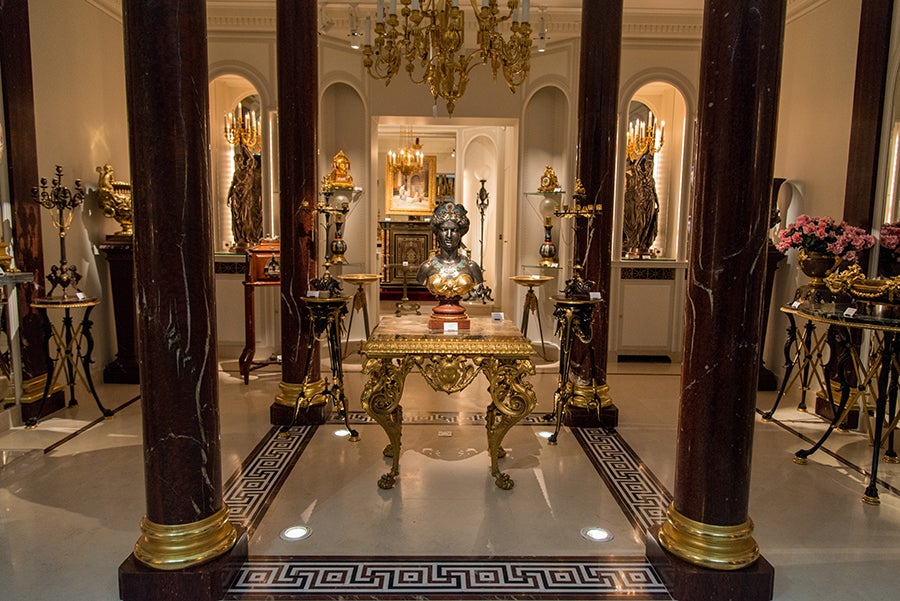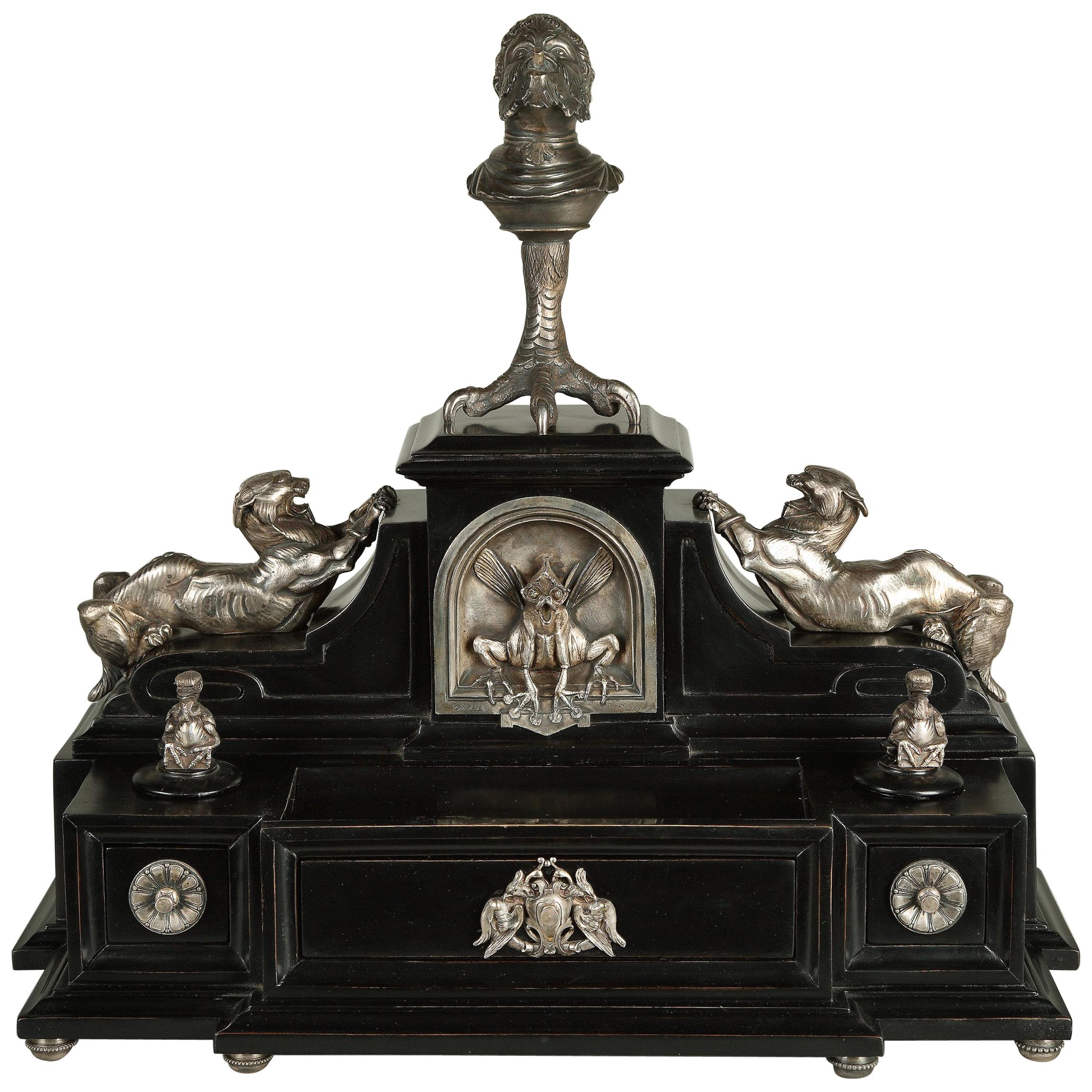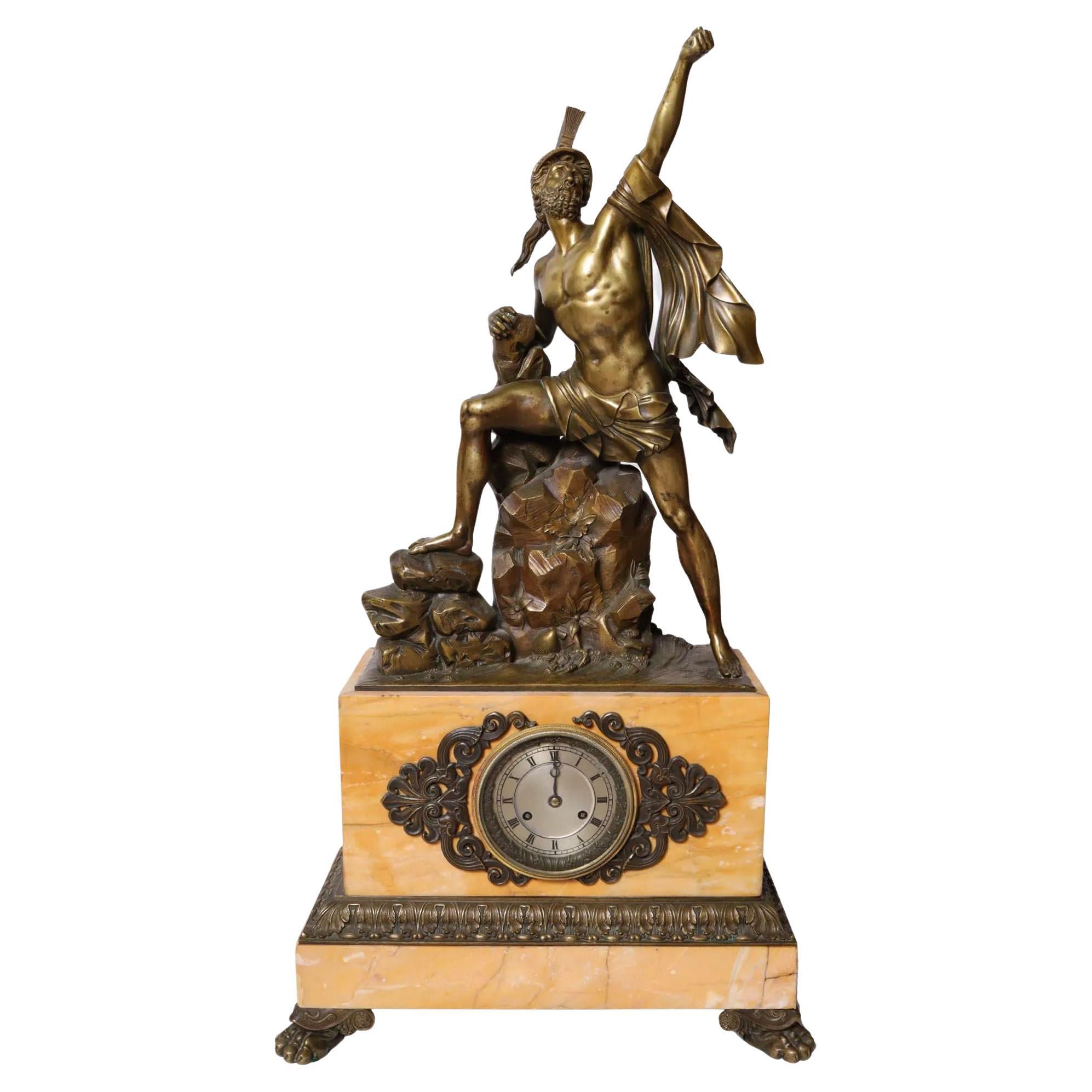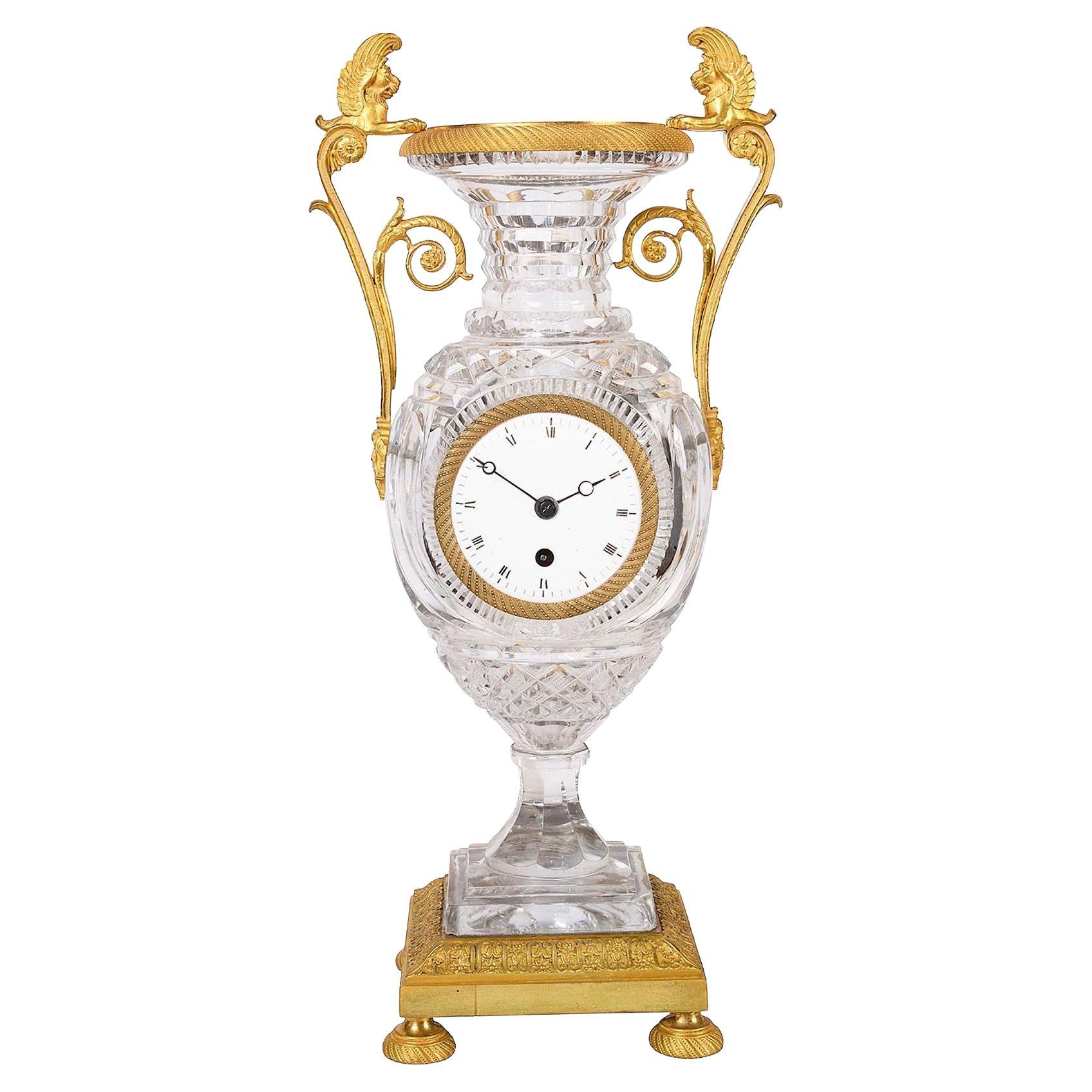Items Similar to Fine Neo-Greek Clock Set by H. Houdebine, France, Circa 1867
Want more images or videos?
Request additional images or videos from the seller
1 of 10
Fine Neo-Greek Clock Set by H. Houdebine, France, Circa 1867
About the Item
Dial signed H. Houdebine, Fabricant de Bronzes, Rue de Turenne 64, Paris
and clockwork signed Japy Frères & Cie – Médaille d’Honneur
A very fine neo-Greek style clock set made up of a clock and a pair of candlesticks. The clock executed in two patina bronze is surmounted by a covered vase and is decorated with porcelain plaques depicting female faces and Art attributes. The Roman numerals on the dial are framed with laurel wreaths. Raised on console feet and a base, the whole reposing on four claw feet. The ensuite pair of two patina bronze candlesticks is finely chased with small flowers and water leaves.
Henri Houdebine founded his company in 1845. He gained a great reputation in the making of clocks and decorative bronze pieces. His works, appreciated for their high artistic quality, took inspiration from various styles, including the neo-Greek style, very fashionable with artists in the 1860s. His work was immediately successful with the public, and one can say from 1862, that 50% of his production was exported. Houdebine set up his workshops at number 64, rue de Turenne, in Paris during the period 1865-1880. He participated magnificently in several Universal Exhibitions, such those held in Paris in 1855, where he was awarded a 2nd class medal for his statuettes and display cups, in London in 1862, and again in Paris in 1878 and 1889, where he won a Gold medal for his all the works he exhibited. Houdebine participated finally in the Chicago Universal Exhibition of 1893, where he presented splendid cressets, clocks and some sculptures.
- Creator:Henri Houdebine (Maker)
- Dimensions:Height: 19.69 in (50 cm)Width: 11.03 in (28 cm)Depth: 6.7 in (17 cm)
- Sold As:Set of 3
- Style:Greek Revival (In the Style Of)
- Materials and Techniques:
- Place of Origin:
- Period:
- Date of Manufacture:Circa 1867
- Condition:Wear consistent with age and use.
- Seller Location:PARIS, FR
- Reference Number:

About the Seller
4.9
Vetted Seller
These experienced sellers undergo a comprehensive evaluation by our team of in-house experts.
Established in 1997
1stDibs seller since 2018
73 sales on 1stDibs
Typical response time: <1 hour
Associations
International Confederation of Art and Antique Dealers' Associations
- ShippingRetrieving quote...Ships From: PARIS, France
- Return PolicyA return for this item may be initiated within 7 days of delivery.
More From This SellerView All
- Neo-Greek Inkwell by C.G. Diehl, E. Frémiet and J. Brandely, France, Circa 1867By Jean Brandely, Emmanuel Fremiet, Charles-Guillaume DiehlLocated in PARIS, FRSigned Diehl à Paris. Wood and silvered copper inkwell. Central drawer ornamented with an escutcheon and flanked by two small lateral drawers forming two containers, surmounted by a lid representing a nestling. Central niche ornamented with a winged creature. Inkwell flanked by two felines. Toped by a penholder representing a Moorish head resting on an eagle claw. This exceptional piece was realized thanks to the collaboration of ornemanist J. Brandely, sculptor E. Frémiet and cabinet-maker C.-G. Diehl. The motif of the fantasy creature dear to Diehl, is to be seen on the famous cabinet made by him in 1867 and now exhibited at the Metropolitan Museum of Art in New York (Inv. 1989.197). Arriving in Paris in about 1840 Charles-Guillaume Diehl (1811-1885) founded his cabinet making and decoration firm at 19 rue Michel-le-Comte in 1885. His workshops produced elegant little pieces of furniture in rosewood and thuja and novelties with bronze and porcelain embellishments (see “Les ébénistes du XIXème siècle”, D. Ledoux-Lebard, Ed. de l’amateur, 1982, p.164). It was his luxury boxes, however (liqueur cellarettes, cigar cabinets, games boxes, cashmere cases, jewelry cases) which assured Diehl’s renown (see “l’Art en France sous le Second Empire”, Exposition Grand-Palais, Paris, 1979, p.133). Already rewarded with a bronze medal at the Universal Exhibition of 1855 in Paris, he exhibited a jardinière with china columns and a liqueur cabinet at the Industrial Arts Exhibition in 1861. In collaboration with the designer Jean Brandely (active from 1867 until 1873), Diehl renovated his decorative repertory and created astonishing pieces of furniture in the Grecian style which had a dazzling success at the Universal Exhibition in Paris in 1867, where his cabinets also won a silver medal. Certain motifs were so typical of Diehl’s work that they received extensive commentary by the art critic J. Mesnard in his book “Les Merveilles de l’Exposition Universal de 1867” (vol. II, pp. 133 & 149). He writes of a table of which “the pendant bearing hooks and the fan shaped radiating motif which ornaments the entablature are engraved with love” (p. 133) and a jewelry case where “The head in fine Grecian style makes up the essential part of the fine gilt bronze ornamentation” (p. 149). For this Universal Exhibition Diehl also formed a partnership with two famous sculptors: Emile Guillemin (1841-1907) who carved the relief for a mahogany sideboard with galvanic gilt bronzes (Orsay Museum, Paris, Inv. O.A.O. 992) and Emmanuel Frémiet (1824-1910) who executed the low relief for a cedar medal cabinet...Category
Antique 1860s French Greek Revival Inkwells
MaterialsCopper
- Pair of Neo-Greek Pedestals. C.G. Diehl & J.Brandely, France, circa 1867By Jean Brandely, Charles-Guillaume Diehl, Lebeuf Milliet & Cie Creil MontereauLocated in PARIS, FRExceptional pair of neo-Greek style pedestals, made in blackened pearwood, gilded galvanic bronze and glazed earthenware. The sheath-shaped shaft is decorated with rectangular plates...Category
Antique 1860s French Greek Revival Pedestals
MaterialsBronze
- Neo-Greek Cigar Cellarette, C.G. Diehl, E. Frémiet & J. Brandely, Circa 1867By Jean Brandely, Emmanuel Fremiet, Charles-Guillaume DiehlLocated in PARIS, FRRare cigar humidor made in wood, with a front flap, discovering five sliding cane trays. Beautiful bronze and silver electroplated brass ornaments, such as the central niche decorated with a winged creature, surmounted on top of the cabinet with a feline. Resting on four tall legs joined by a stretcher decorated with a silvered pierced bronze incense burner. The central relief of that cellarette for cigars, with that fantasy creature, is directly inspired from the one designed by J. Brandely for the front door of the Merovingian Cabinet made by Diehl in 1867, and now preserved at the Metropolitan Museum of Art in New York (Inv. 1989.197). Arriving in Paris in about 1840 Charles-Guillaume Diehl (1811-1885) founded his cabinet making and decoration firm at 19 rue Michel-le-Comte in 1885. His workshops produced elegant little pieces of furniture in rosewood and thuja and novelties with bronze and porcelain embellishments (see « Les ébénistes du XIXème siècle »,D. Ledoux-Lebard, Ed. de l’amateur, 1982, p.164). It was his luxury boxes, however (liqueur cellarettes, cigar cabinets, games boxes, cashmere cases, jewelry cases) which assured Diehl’s renown (see « l’Art en France sous le Second Empire », Exposition Grand-Palais, Paris, 1979, p.133). Already rewarded with a bronze medal at the Universal Exhibition of 1855 in Paris, he exhibited a jardinière with china columns and a liqueur cabinet at the Industrial Arts Exhibition in 1861. In collaboration with the designer Jean Brandely (active between 1867 and 1873), Diehl renovated his decorative repertory and created astonishing pieces of furniture in the Grecian style which had a dazzling success at the Universal Exhibition in Paris in 1867, where his cabinets also won a silver medal. Certain motifs were so typical of Diehl’s work that they received extensive commentary by the art critic J. Mesnard in his book « Les Merveilles de l’Exposition Universal de 1867 » (vol. II, pp. 133 & 149). He writes of a table of which « the pendant bearing hooks and the fan shaped radiating motif which ornaments the entablature are engraved with love » (p. 133) and a jewelry case where « The head in fine Grecian style makes up the essential part of the fine gilt bronze ornementation » (p. 149). For this Universal Exhibition of 1867, Diehl also formed a partnership with two famous sculptors : Emile Guillemin (1841-1907) who carved the relief for a mahogany sideboard with galvanic gilt bronzes (Orsay Museum, Paris, Inv. O.A.O. 992) and Emmanuel Frémiet (1824-1910) who executed the low relief for a cedar medal cabinet...Category
Antique 1860s French Greek Revival Tobacco Accessories
MaterialsBrass, Bronze
- Neo-Egyptian Bronze and Marble Clock Attributed to G.Servant, France, Circa 1870By Georges Emile Henri ServantLocated in PARIS, FRA black and red marble clock in the shape of an Egyptian temple attributed to G. Servant, flanked by double columns inscribed with hieroglyphs and ornated with a winged uraeus, all made in two patina bronze. The clock is surmounted by a patinated bronze sphinx. Resting on four bronze faces wearing the nemes and terminating in lion paw feet. Georges Emile Henri Servant (circa 1828-1890) who took over his father in 1855 at their foundry, rue Vieille-du-Temple, in Paris, specialized in the production of neo-Egyptian style clocks, very popular in France since 1860s, and also the making of Greek style decorative objects. He drew considerable attention to the high quality of his bronzes at the 1855 Paris Universal Exhibition and then at the 1862 London Exhibition. At this time Servant exported up to 40% of his production, principally to the United States, where for instance, his sphinx clocks were sold with great success by Louis Tiffany Inc. or Hamann & Roche of New York (A similar clock is now exposed at the Metropolitan Museum of Art, New York). But his success came really at the 1867 Paris Universal Exhibition, where he was awarded a gold medal for his neo-Greek and Egyptian works (Les Merveilles...Category
Antique 1870s French Egyptian Revival Mantel Clocks
MaterialsMarble, Bronze
- Clock with Cupids by D'Aureville, Chameroy and Maison Barbot, France, c. 1860Located in PARIS, FRSigned D’Aureville et Chameroy, Maison Barbot A very fine Greek style clock made in gilded bronze, standing on four claw feet. Topped with two cherubs reading a floor plan. The...Category
Antique 1860s French Greek Revival Table Clocks and Desk Clocks
MaterialsBronze
- Large Neo-Greek Vase by F. Levillain & F. Barbedienne, France, circa 1890By Ferdinand Levillain, Ferdinand BarbedienneLocated in PARIS, FRImportant neo-Greek vase in the shape of an Amphora, made in two patina bronze. The body is decorated with a rich continuous frieze in bas-relief presenting a procession of characters carrying their offerings to the temple, underlined by a decoration of theatrical masks among olive trees. The 's'-scroll handles decorated with grape vines, resting only on the shoulder of the vase, are supported by a ram’s head. Numerous palmettes and friezes adorn the whole. Resting on a molded marble circular base. Biography Ferdinand Levillain (Paris, 1837-1905) studied under the sculptor Jouffroy (1806-1882), before making his debut in 1861 at the French Artists Salon where he continued to exhibit until 1903. At the 1867 Universal Exhibition in Paris, he was praised for a Neo-Greek style bronze cup he made for the firm Blot and Drouard. He was not to become really famous, however, until 1871 thanks to his association with the great bronze founder Ferdinand Barbedienne, who began to exhibit Neo-Greek style lamps...Category
Antique 1890s French Greek Revival Vases
MaterialsMarble, Bronze
You May Also Like
- Greek Neoclassical Bronze Mantel Clock by Honore PonsBy Honoré PonsLocated in New York, NYOur Greek Revival period mantel clock in bronze with Siena marble case comes from the celebrated French horologist, Pierre-César Honoré Pons (1807-1846), c...Category
Antique Mid-19th Century French Greek Revival Mantel Clocks
MaterialsMarble, Bronze
- Fine Quality French Empire Baccarat Style Crystal Vase Clock, circa 1860By BaccaratLocated in Brighton, SussexA fine quality French Empire style Baccarat hobnail cut lead crystal glass two handled vase clock with ormolu-mounts, having a white enamel clock face with roman numerals and raised ...Category
Antique 19th Century French Empire Revival Mantel Clocks
MaterialsOrmolu
- Gilt Bronze & Marble Greek Revival Mantel Clock w. Goddess Athena Sculpture 1880Located in Lisse, NLFine and meaningful, 19th century, goddess of war theme clock. Throughout the 19th century, French artisans have made some of the most amazing quality and meaningful antiques using the most expensive materials and techniques available. This finest quality made and relatively small mantle clock has all of that and that is why it resonates a timeless style that you don't find anymore in this day and age. On top of this clock you have the beautiful Athena bust...Category
Antique 19th Century French Greek Revival Mantel Clocks
MaterialsMarble, Brass, Enamel, Bronze, Metal
- Fine Marble French Art Deco Mantle Clock Set with Garnitures, circa 1920Located in Swedesboro, NJFor customers that require professional insured delivery we are proud to have teamed up with a nationwide professional delivery company that will assist with coordinating your delive...Category
Vintage 1920s French Art Deco Mantel Clocks
MaterialsBreccia Marble
- French Greek Revolutiom Ormolu Mantel ClockLocated in London, GBFrench Charles X period Greek Revolution or Hellenistic mantel clock. The clock in original ormolu with a Turkish figure to the top. The silvered dial ha...Category
Antique 1830s French Mantel Clocks
MaterialsOrmolu
- Fine Quality French Ormolu and White Marble Clock SetLocated in New York, NYA fine quality French ormolu and patinated bronze and white marble clock set with cherubs holding the candelabras and large central clock with two fem...Category
Antique 19th Century French Mantel Clocks
MaterialsCarrara Marble, Bronze
Recently Viewed
View AllMore Ways To Browse
Decorative Table Pieces
Made In Greece
Bronze Greek
Greek French Bronze
Greek Gold Signed
Greek Face
Greek Gold Decorative Object
French Watering Can
Greek Porcelain
Greek Revival Style
Greek Roman Bronze
Pair Decorative Console Tables
Greek Patinated Bronze
Antique French Watering Can
French London Clock
Greek Roman Framed
Set De Table Antique
Twos Company Clock





